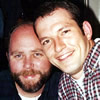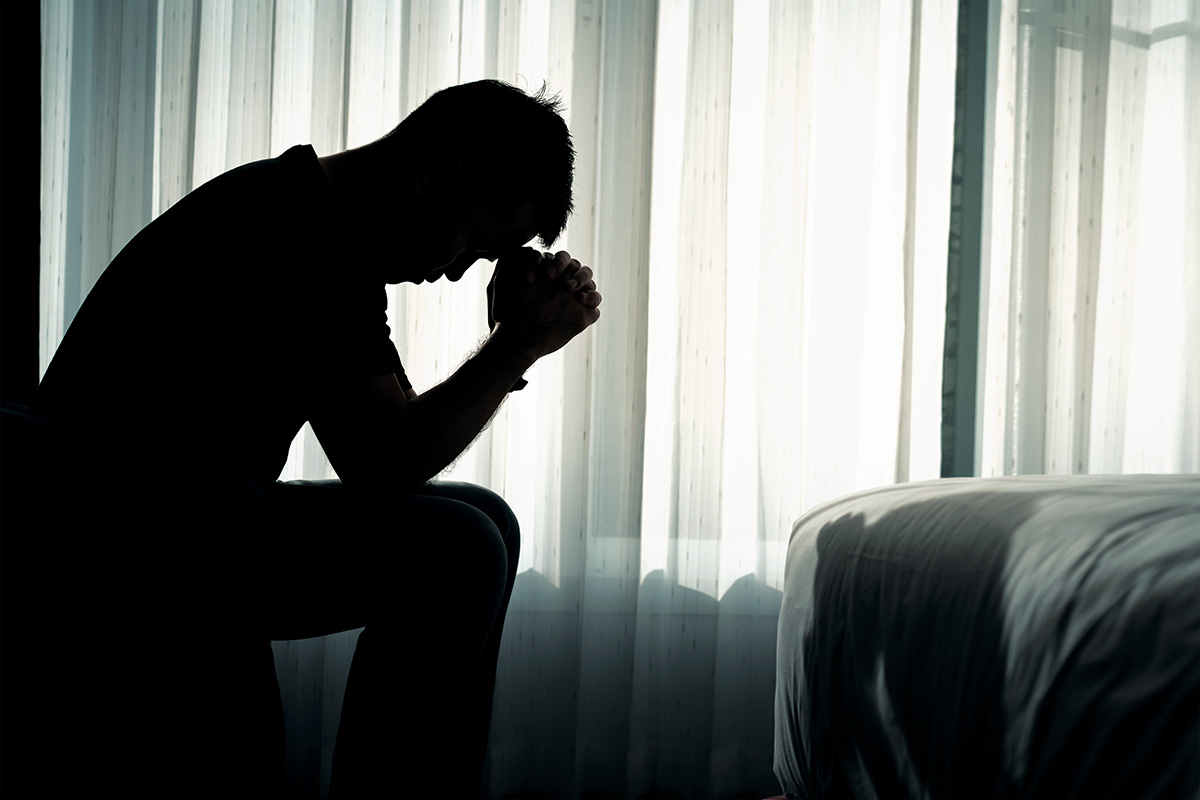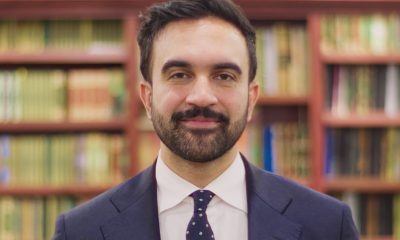Living
From the archives: Gays among heroes, victims of Sept. 11
Our archives piece profiling many of the LGBT dead found in the 5th anniversary of the Sept. 11 attacks issue.

This piece ran in the Blade’s five-year anniversary issue in September 2006. It lists some of the known LGBT victims of the Sept. 11 attacks and shows that families of all types were affected by the terrible events of that tragic day. It also shows that many of the 9/11 heroes who saved countless lives were lesbian, gay, bisexual or transgender.
RENEE BARRETT-ARJUNE
Irvington, N.J.
Renee Barrett-Arjune, 41, was working in One World Trade Center at the time of the attacks. An accountant for Cantor Fitzgerald, she was able to escape the building prior to its collapse.
However, she suffered serious burns in the attack, and was hospitalized at Cornell-Presbyterian Hospital, where she died more than a month later on Oct. 18, 2001.
Barrett-Arjune had been a member of the Metropolitan Community Church of New York. She left behind her partner, Enez Cooper, and her 18-year-old son, Eddie, who lived with them.
GRAHAM BERKELEY
Boston
Graham Berkeley, 37, a native of England who lived in Boston, boarded United Airlines Flight 175 on Sept. 11, 2001, on his way to a conference in Los Angeles. He died when the plane became the second highjacked airliner to crash into the World Trade Center.
Berkeley’s parents, Charles and Pauline Berkeley, still live in England and watched the crash on television, although it took eight hours to confirm that their son had been on the plane.
“We had seen the fireball ourselves and knew to expect the worst,” Charles Berkeley told the London Mirror. “We watched our child die. He was a brilliant boy, a brilliant man.”
Graham Berkeley worked for Compuserve as product management director and was a professional violinist in Germany and England, the Advocate reported.
MARK BINGHAM
San Francisco
Gay rugby enthusiast Mark Bingham has been hailed as one of a small group of heroes who fought back against hijackers on United Flight 93, which crashed in Pennsylvania. The flight was believed to have been headed to Washington, D.C., likely to attack another national landmark.
Bingham, 31, was a member of the San Francisco Fog, a gay rugby team, and planned to organize a rugby team for this year’s Gay Games in Sydney, Australia.
A tribute page hosted by the team includes an e-mail from Bingham after he had learned that the Fog had been accepted as a permanent member of the California Rugby Football Union.
“Gay men weren’t always wallflowers waiting on the sideline,” he said, applauding the team’s acceptance into the league. “We have the opportunity to let these other athletes know that gay men were around all along — on their little league teams, in their classes, being their friends.”
PAMELA J. BOYCE
New York
Pamela J. Boyce, 43, was a resident of Dyker Heights, Brooklyn, and worked on the 92nd floor of One World Trade Center as assistant vice president of accounting for the New York office of Carr Futures.
Catherine Anello, Boyce’s partner, told the New York Times that Boyce was a no-nonsense person who wouldn’t want her loved ones to be overcome by grief.
“If there was someone who lost a loved one and had been grieving too long, so that they were not living their life, she would say, ‘Stop. It’s not what they would want. They are in a better place.'” Anello said, “She said, ‘I’m not afraid to die because I know where I am going is beautiful.'”
DANIEL BRANDHORST
RONALD GAMBOA
DAVID REED GAMBOA BRANDHORST
Los Angeles
When Daniel Brandhorst and Ronald Gamboa changed their flights so they could return to Los Angeles from Boston on Sept. 11 with adopted son, David, they had no idea of the tragedy that would await them.
Brandhorst and Gamboa had met 13 years ago at a party. Family friend Donato Tramuto told the New York Times Gamboa “could make a rainy day look happy.” Meanwhile, Scott Pisani, a fellow employee at PriceWaterhouseCoopers, said Brandhorst “made a tremendous amount of time for his family” after David was born, and would often take the toddler to work.
David, 3 at the time of his death, was adopted at birth by Gamboa and Brandhorst. Brandhorst, 41, worked an accountant for PriceWaterhouseCoopers, and Gamboa, 33, was the manager of a Gap store. They were on United Airlines Flight 175.
DAVID CHARLEBOIS
Washington, D.C.
David Charlebois, 39, first officer on American Airlines Flight 77, which collided into the Pentagon after being hijacked by terrorists, died while flying one of his standard routes.
Charlebois lived near the District’s popular Dupont Circle neighborhood with his partner of 14 years, Tom Hay, and their border collie, Chance.
He began his career as a pilot for corporate executives and later worked as a pilot for U.S. Airways. He joined American Airlines a decade ago, where he served as first officer, or co-pilot, flying mostly transcontinental routes out of Dulles International Airport.
Hay said Charlebois’ loyalty to his friends, family, and community was rivaled only by his love for flying.
“He always wanted to be a pilot,” Hay said.
Charlebois was an active member of the National Gay Pilots Association and had worked quietly within his company as an advocate for rights of gay employees, including gay pilots.
EUGENE CLARK
New York
Eugene Clark, 47, observed “the three D’s: dance, drama and divas,” according to the New York Times. His partner of 13 years, Larry Courtney, said Clark had grown up listening to Roberta Flack, loved Broadway musicals and could dance “like Tina Turner… and he had legs almost as good.”
Clark worked for the Aon Corporation as an administrative assistant, but it was his time away from the office that he enjoyed most. He had converted a 10-foot by 24-foot concrete-slab patio into a thriving terrace garden.
He also “adored the musicals ‘Miss Saigon’ and ‘Les Miserables,’ cooked Southern-style fried cabbage, and collected Waterford crystal decanters and vases,” the Times reported.
JEFFREY COLLMAN
Jeffrey Collman, 41, a flight attendant on American Airlines Flight 11, died when the hijacked jet slammed into the North World Trade Center tower in the first attack of Sept. 11, 2001.
A three-year employee of American Airlines, Collman had changed to the Boston-Los Angeles route from his normal Boston-San Francisco flights in order to prepare for an upcoming vacation.
Keith Bradkowski, Collman’s partner, had last heard from him the evening prior to the crash, when Collman called to talk about their upcoming trip, according to the San Jose Mercury News.
Collman received the American Professional Flight Attendant Award in 1999. In addition to Bradkowski, the Illinois native was survived by one sister and four brothers.
LUKE DUDEK
Livingston, N.J.
Luke Dudek and his partner of 20 years, George Cuellar, had dreamt of buying a building to house their high-end floral design store.
On Sept. 11, 2001, that dream finally became a reality. But Dudek, 50, wasn’t there to celebrate, according to Newsday.com.
Dudek was working as a food and beverage controller at Windows on the World, the restaurant at the top of One World Trade Center, that morning, when terrorist planes struck the building.
Dudek’s partner, George Cuellar, continues to run the flower shop he operated with Dudek for 16 years. He said the couple had no regrets in life.
“Everything we did, we did with love,” Cuellar told Newsday. “He’ll always be my best friend. I feel very protected by him. And I always did.”
JOE FERGUSON
Washington, D.C.
James Joe Ferguson, director of geography education outreach for the National Geographic Society, was on American Airlines Flight 77 when it crashed into the Pentagon. Ferguson was traveling on a National Geographic-sponsored educational field trip to the Channel Islands National Marine Sanctuary off Santa Barbara, Calif.
Ferguson, 39, was accompanying a colleague, three teachers, and three sixth-grade students, all from Washington, on the trip.
Ferguson lived on Capitol Hill for 10 years with Winston, his wire-haired fox terrier. He was one of the principal architects who designed the infrastructure of geography education, which resulted in the improvement of geography education throughout the United States, according to National Geographic.
“Ultimately, what he did touched over 150,000 students and teachers — and that is just one person,” said Ed Kaczmarek, a friend of Ferguson’s for 14 years.
CAROL FLYZIK
Plaistow, N.H.
Carol Flyzik, a 40-year-old registered nurse and a member of the Human Rights Campaign, was on American Airlines Flight 11 on her way to California when her plane became the first to crash into the World Trade Center.
Flyzik was a marketing supervisor for Meditech, a software company that serves the medical community. She was headed to California on a business trip at the time.
She left behind a partner of nearly 13 years, Nancy, as well as three stepchildren whom she cared for as her own.
SHEILA HEIN
University Park, Md.
Sheila Hein, an analyst, was working for the U.S. Army’s management and budget office in the Pentagon when American Airlines Flight 77 crashed into it.
Hein, 51, lived with her partner of 17 years, Peggy Neff, in University Park, Md. They bought a house there seven years ago as a “fixer-upper” and turned the backyard into their “own private park,” Neff told the Washington Post. “She is what this yard is. There’s a whole lot of love here,” Neff said.
Hein worked at the Pentagon for the last five years as a visual information specialist for the Army and had only recently changed jobs. She was at the Pentagon that day taking part in an Army internship, studying manpower analysis. A native of Springfield, Mass., she joined the Navy after high school and was sent to Virginia. She spent 10 years in the service as a photographer, married twice, and ventured into a career in computer graphics, working on government contracts.
Hein received a bachelor’s degree from Columbia Union College three years ago after taking courses on and off for 20 years. “She decided it was time to finish it,” Neff told the Post. She planned to get a master’s degree.
MYCHAL JUDGE
New York
New York City Fire Department Chaplain Mychal Judge was killed during the collapse of the World Trade Center towers while administering last rites to a dying firefighter. Fellow firefighters carried his body to St. Peter’s Church and then back to the firehouse.
Judge, 68, had been a Catholic chaplain for the New York City Fire Department since 1992. “Father Mike,” as the gay priest was known, was laid to rest in a memorial service attended by more than 3,000 and presided over by Cardinal Edward M. Egan.
Judge was also a “longtime member” of Dignity/USA, according to the Web site of the organization for “gay, lesbian, bisexual and transgendered Catholics, our families and friends.”
WILLIAM ANTHONY KARNES
New York
William Anthony Karnes and his partner, John Winter, could see Karnes’ office at Marsh & McLennon on the 97th floor of One World Trade Center from the home they shared.
On the morning of Sept. 11, 2001, the 37-year-old Karnes left for the office as usual at 8:30 a.m. The “commute,” which took about 11 minutes, would be his last. At 8:45, Winter heard what sounded like a thunder, and immediately looked out his apartment window.
“At that point, I knew probably a lot of hope was lost that I’d ever see him again,” Winter told LGNY. “Death doesn’t discriminate. Death actually transcends sexual orientation.”
JACK KEOHANE
New York
John Keohane, 41, worked at One Liberty Plaza near the World Trade Center and died when the towers collapsed. After the planes hit the Trade Center towers, Keohane met Mike Lyons, his partner of 17 years, on the street, and called his mother from his cell phone.
“They were just in the streets like everybody else,” his sister, Darlene Keohane, told the San Francisco Chronicle. “As he was talking, he had thought a third plane crashed into the building.”
What Keohane thought was a third crash was really the collapse of the South tower of the World Trade Center. While Lyons survived, Keohane was killed by falling debris.
A native of San Francisco, Keohane had lived in the New York area for a year. Distraught over Keohane’s death, Lyons committed suicide on March 1.
MICHAEL LEPORE
New York
Michael Lepore’s friends now take care of his rosebushes and plants in the garden that had been his pride and joy.
“We used to say nothing bad could ever happen here,” Lepore’s partner of 18 years, David O’Leary, told the New York Times. “And it’s still the most important thing. It’s where I see most of Michael.”
Lepore, 39, was a project analyst at Marsh & McLennan. He shared a home, designed by Frank Lloyd Wright apprentice Edgar Tafel, with O’Leary and their three cocker spaniels, and the couple was in the midst of helping to plan Lepore’s youngest brother’s wedding.
O’Leary said, a month prior to the attacks, their house had been bustling with friends and family.
“Everything was so perfect in our lives,” he said. “Just so perfect.”
PATRICIA McANENEY
New York
Patricia McAneney, 50, always wanted to be a firefighter. While she never actually became one, she did serve as fire marshal for the floor in One World Trade Center where her employer, Guy Carpenter insurance company, had its offices.
Her friends and partner remembered her for her honesty.
“If one of us committed a crime, Pat would be the last person we could go to because she would turn you in,” McAneney’s partner of nearly 20 years, Margaret Cruz, told the New York Times. “She said she might give me a few hours’ head start.”
WESLEY MERCER
New York
Wesley Mercer, the vice president of corporate security for Morgan Stanley, was generally a quiet man. But his partner, Bill Randolph, told the New York Times that Mercer also could be a leader during a crisis.
That’s what he did on Sept. 11, 2001. The World Trade Center towers fell as Mercer helped evacuate other employees
“It put a hole in my stomach,” Randolph told the paper. “But I knew that’s what he would have done.”
Mercer, who was divorced and had two daughters, became a security officer after serving in the military, and was known for his formal style. “He always thought the way he carried himself was important,” Randolph said.
PHILIP “ROXY EDDIE” OGNIBENE
New York
“Roxy Eddie” Ognibene, a member of the Renegades of New York’s Big Apple Softball League, was killed last Sept. 11 while working as a bond trader for Keefe, Bruyette & Woods on the 89th floor of Two World Trade Center, according to Outsports.com.
Ognibene, 39, was considered by his friends to be “a strong lefty hitter, a flawless first baseman,” and a solid pitcher and outfield player, the gay sports Web site reported. Those who knew him said his sense of humor was contagious, and just to see him was to laugh out loud.
Although his work often left him too busy to pursue outside hobbies, Ognibene had a love of softball and had just recently joined the league. During one particularly nasty practice, which occurred in the middle of a downpour, Ognibene was the last to leave the field.
“I don’t care,” he said, friend Ben Moon recounted to Outsports. “I just love to play softball.”
CATHERINE SMITH
New York
Catherine Smith, 44, worked on the 92nd floor of the first World Trade Center tower as a vice president for Marsh & McLennon when tragedy struck last Sept. 11.
Smith and her partner of six years, Elba Cedeno, considered themselves very similar to Pepe Le Pew and Penelope from the Looney Tunes cartoons, according to the New York Times. “They had known each other, in passing, for 20-odd years, both frequenting the same bar,” the paper reported. Later, when both had ended other relationships, they officially met.
The two were together for six years.
“This was my soul mate. We planned to live the rest of our lives together and retire together,” Cedeno said.
From staff and wire reports
Real Estate
In real estate, trust the process
With rates coming down, we could see spring surge in buyers

The average 30-year mortgage rate is falling, little by slowly. With predictions that the rate will continue to adjust downward in the next year or two, there may be a busier spring market than we have seen in the last few year, especially for the DMV market, which has been reeling from thousands of layoffs this past year. The frenzied activity resulting from interest rates close to 3% for some borrowers will probably not occur; however, this spring could add up to be a few notches busier than the last.
What does this mean for buyers and sellers? Lender Tina Del Casale with Waterstone Mortgage says she has seen “low to mid 6’s as the average for conventional loans.” If rates continue downward into the 5% range, there may be more activity than we saw in the last year or two. This could release a little bit of pent up demand.
Many buyers will have found that for whatever reason, their current home is not meeting their needs. Sellers may want to finally take the plunge and put a for sale sign in the yard and online, now that they might find a more reasonable rate on their next home. This winter can be an opportunity to assess financial situations, home conditions, and optimize one’s chances to have a sale with more agreeable terms, or put one’s best foot forward in an offer. In addition to checking with a lender or favorite handy person, let’s review what sellers and buyers typically spend their energy negotiating while enjoying the lovely process called “going under contract”:
- Timelines – Sellers might want to have their house solidly under contract (papers signed, thumbs up from the lenders, all inspection items decided upon and settled) so that they can put an offer down on a new home, and then negotiate that timeline with the other sellers. Remember, making a move is not only about the buyer taking possession of a new home, but also about the sellers figuring out their situation as well.
- Sale Price – unfortunately for buyers, in the eyes of most sellers, “money talks.” So, in a non-competitive situation, a seller might be happy to just get one offer at a price that was within the desired range. As soon as another interested buyer enters the equation, it can become a little bit like RuPaul’s Drag Race, and one will have to lip sync for one’s life, honey! And only one buyer will get to hear the words, “condragulations!”
- Tone/Vibes/Energy in the Room – Remember: Human beings are emotional creatures. All of us have feelings. And all of us want to put energy into situations where we feel appreciated, where a level of self-awareness exists, and a sense that each side is trying one’s hardest to act in good faith. The best transactions I saw were where a little grace was the “grease on the wheels” of the transaction. Occasionally, a buyer had cold feet and wanted to see the unit a few more times before the settlement date, or a seller forgot to scrub the bathroom with a little extra elbow grease before the settlement date. Life happens; misunderstandings can occur. A wise therapist once said: “You don’t have to like it, but can you allow it?” The tone of one or both parties in the transaction can be what seals the deal, or results in one party exiting the contract. (In the case of the dirty bathroom, the seller left a check with the title company for the buyer to pay a housekeeper to come clean what they couldn’t.)
Joseph Hudson is a referral agent with Metro Referrals. He can be reached at 703-587-0597 or [email protected].
Real Estate
Signs you’ve outgrown self-management of your D.C. rental
Keeping up with local regulations is a struggle

According to rental market statistics from RentCafe, Washington, D.C., remains at the top of the most popular cities for rental properties. With a strong rental market and a growing population, success should be second nature to real estate investors and rental property owners in this area.
As a self-manager of your own rental, if you’re not enjoying the profitability and the earnings that this market can provide, it might be time to look for professional management.
There are certain signs that show property owners have outgrown self-management. We’re exploring those today, and inviting DIY landlords to consider the benefits that come with a partnership with a professional property management company in Washington, D.C.
Washington, D.C., is known for having a complex and ever-changing regulatory environment. There are strict tenant rights, rent control laws, and specific rules related to property maintenance such as mold, lead based paint hazards, among others. The Rental Housing Act of 1985 is strictly enforced, and under this program, there are specific rules regarding rent adjustments, dispute resolution, and eviction protections.
Fair housing laws need complete compliance, security deposits have strict timelines, and habitability standards are in place to ensure tenants are living in a home that’s safe and well-maintained.
Staying on top of these rules can be time-consuming and difficult. Violating even a small regulation unintentionally can result in fines or legal action. It’s critical to stay compliant, and if you find yourself struggling to keep up with the evolving laws and regulations, it’s a clear sign that you may need professional help. Property managers can reduce the risk and liability of making a legal mistake.
Financial Returns are Underwhelming
A lot of self-managing landlords choose to lease, manage, and maintain their own properties because they don’t want to pay a management fee. We get it. Keeping more of your money seems like the best way to increase profitability.
But, here’s the reality of it: property managers can help you earn more and spend less on your investment, increasing your earnings and your ROI. In fact, a good property manager can often earn enough additional net revenue for the owner to pay for that fee over a year.
Property managers are experienced at maximizing the financial performance of rental properties. We can help:
- Optimize rental income
- Reduce vacancy rates
- Lower maintenance costs through established vendor relationships
- Recommend improvements for higher values
Ultimately, a good property manager will ensure that your property is being run efficiently. We will use our expertise to ensure your property is earning what it should.
Maintenance and Repairs Are Taking Up Too Much Time
Maintenance challenges are not unique to self-managing rental property owners. We deal with them, too, as professional property managers. We respond to plumbing issues and appliance malfunctions, we take calls in the middle of the night when a sewer is backing up, and we work hard to protect properties against deterioration and general wear and tear.
This can be overwhelming, especially when it comes to finding vendors and service professionals that are both affordable and provide quality service. Plumbers, electricians, HVAC technicians, and even landscapers and cleaners are in high demand in Washington, D.C. But maintenance at your rental property cannot wait. It’s essential to the value and condition of your investment as well as to the product you are selling.
It’s time to work with a professional property manager if you’re having trouble finding vendors or if you’re struggling to keep up with maintenance requests. We have systems for emergency responses, routine repairs, and preventative services.
Tenant Screening Is Becoming More Difficult and Time-Consuming
Finding good tenants is one of the most critical aspects of rental property management. But in our home of Washington, D.C. we have one of the most regulated rental markets in the country. The tenant screening process has become increasingly complex, highly restricted, and time-intensive.
Many property owners are surprised to learn that there are more limitations than ever on what can be screened, what information can be used in making a decision whom to rent to, and how screening decisions must be documented. Federal and local laws tightly regulate the use of credit histories, criminal background records, income verification, and even eviction records. Staying compliant is not optional. Failure to follow these rules can open the door to discrimination claims, administrative complaints, substantial fines, or even lawsuits.
That’s why rushing or relying on outdated methods can easily result in selecting the wrong resident or worse, unintentionally violating DC’s Human Rights Act or federal Fair Housing laws.
Problematic tenants often become evident only after move-in: lease breaks, chronic late payments, noise complaints, and property damage. When these patterns appear repeatedly, it is often a sign that the screening process is not sufficiently structured.
Why Professional Screening Matters
Professional property managers have systems in place to perform thorough, legally compliant screening while avoiding oversteps that could violate the regulations. Professional property managers use trusted screening platforms and follow written processes that keep owners protected and ensure fairness for applicants.
Columbia Property Management’s screening process includes:
- Credit Report Review
Evaluating credit patterns, payment reliability, and debt load while complying with restrictions on how data can be used. - Rental History Verification
Contacting prior landlords and reviewing national eviction databases—keeping in mind that some jurisdictions like the District of Columbia limit how far back eviction data can be seen, must less considered. - Background ChecksReviewing public records in a manner consistent with DC’s Human Rights Act and federal guidance on criminal history usage. Not all criminal records can be considered in rental decisions, and timing rules often apply.
- Income & Employment Verification
Confirming applicants can afford the rent and other monthly expenses based on their income, without ruling out certain income in a discriminatory way (e.g., vouchers, subsidies, or lawful alternative forms of income). There are many intentional steps conducted by professional property managers under a framework that ensures decisions are based on objective criteria, applied consistently, and fully aligned with the latest federal and DC regulations.
Your Property Is Sitting Vacant for Longer Periods
While current rental market dynamics are starting to show the effects of federal workforce layoffs and the worsening local economy, the vacancy rate in Washington, D.C., is relatively low, compared to the national average. According to a news report from WTOP, the local vacancy rate is just 6%, and there are an average of seven applications for every available rental unit.
A vacant rental property can quickly become a financial drain. Whether you own a condo near Dupont Circle or a single-family home in one of Capitol Hill’s neighborhoods, every day your property sits empty means lost income. While the D.C. market is generally competitive, the reality is that there are always fluctuations in demand based on seasons, neighborhood desirability, and even economic trends.
If you’re struggling to fill your rental quickly, it might be a sign that you need to re-evaluate your approach. An experienced property management company has a marketing strategy in place to keep vacancy periods as short as possible. From professional photos and listings to leveraging established networks, they can help ensure that your property is rented quickly, reducing the amount of time it sits vacant.
While managing a rental property in Washington, D.C., can be rewarding, it’s also challenging. As your property portfolio grows or the demands of your life or the demands of being a landlord increase, it’s helpful to recognize when it’s time to step back and let a professional handle the day-to-day tasks.
From navigating complex local regulations to ensuring your property remains occupied and well-maintained, there are many reasons why rental property owners in Washington, D.C., outgrow self-management. If any of these signs resonate with you, consider partnering with a property management company like ours to ensure that your rental investment continues to thrive without the stress and burnout of self-management.
We’d love to be your Washington, D.C., property management partner and resource. Please contact us at 888-857-6594 or ColumbiaPM.com
Scott Bloom is owner and Senior Property Manager, Columbia Property Management.
Advice
My federal worker husband is depressed and I don’t know how to help
I feel like he’s dragging me into his hopelessness

Dear Michael,
My husband is a federal worker. Many of his colleagues took “the fork” or have been fired. So work has been overwhelming. He usually works late. The morale in his office is terrible. His paycheck disappeared with the shutdown although due to the specifics of his job, he still had to go in. He’s gotten increasingly depressed, irritable, and short-tempered.
I met Jason 20 years ago when we were young, and one of the things that made me fall in love with him was his idealism. He came to Washington because he wanted to contribute to the well-being of our country.
When I look at him now, it’s like he’s been through the wringer. He’s lost his idealism, feels unappreciated by our country, and is becoming bitter.
He never wants to go out with friends. Either he doesn’t want to hear them complain about the same sorts of things he’s experiencing, or he doesn’t want to have to interact with people who are doing just fine, job-wise.
He also doesn’t feel like going out, just the two of us. So we’re home a lot. But we’re not spending time together when we’re at home. He’s surfing the internet, doom-scrolling, or playing video games.
I can’t get him to talk to me; he says, “I don’t want to talk about anything, it just makes me feel worse.” I can’t get him to do anything that might help him feel better. He doesn’t want to cook dinner with me, he doesn’t want to eat any of his favorite foods that I make for him, he won’t go for a walk with our dog (exercise is supposed to help mood, right?).
I’m really worried about him. Clearly, he’s depressed, and nothing I am trying is helping him to feel better.
But in addition, I am starting to get annoyed. How much more can I try to do things for him that he doesn’t respond to and doesn’t appreciate?
I’ve been OK through this long slog, so far, but now I feel like I am being sucked into his depression and hopelessness. I’m starting to feel like giving up. I’m lonely and I miss my husband and I am despairing that he’s ever really going to come back.
In short, now I hate my life, too.
I’m not going anywhere but I am worried that my main feeling toward him is starting to be apathy. Is there something I can do to help him that I haven’t thought of?
Michael replies:
I’m sorry, this is such a rough time.
It’s understandable that when someone you love is suffering and feeling miserable, you might at times get fed up and feel like pulling away.
There’s a great saying by an ancient Jewish sage, Rabbi Tarfon: While you can’t fix the whole world, that doesn’t mean you should give up and do nothing to help.
I thought of that saying as I read your letter, because while you can’t get Jason to change his mood or take action on his own behalf, you may have some ability to help him.
Similarly, while you can’t have a fantastic time in life when your husband is in a miserable place, you can take care of yourself and likely have a better life than you are having at present.
For starters, I encourage you to keep reminding yourself that this is without doubt one of the hardest periods of your husband’s life. So it’s a very good idea to have an open heart and a lot of compassion for Jason, as much of the time as you can. This won’t be easy. Strive to keep in mind that getting angry at Jason or frustrated with him won’t help.
Don’t try to insist that Jason do anything. Often, when we push someone to do something that they don’t want to do, this just results in their digging in more. People generally don’t like to be nagged.
Of course you can ask Jason if he’d like to join you for a walk, or an outing, but tread carefully. You can advocate for what you’d like, but Jason gets to decide what he wants to do.
You can certainly ask Jason what he would like from you, especially when he’s complaining. I love the “3 H’s” concept: Would he like you to hear (simply listen)? Would he like help (advice on what to do)? Or would he just like a hug?
The best message you can send to Jason, by your presence and by an ongoing loving stance, is “I am here. You’re not alone.” Even when he wants to stay in the basement playing video games. You’re not criticizing him and you’re not judging him. Maybe you’re baking some cookies you both like and leaving him a plateful to eat if and when he wants to. (Be sure to treat yourself to some, as well.)
In terms of bigger interventions, you can suggest that Jason meet with a therapist, or meet with his physician to discuss the possibility of an antidepressant to help him through this awful period. For example, you might have a sincere conversation where you say something like this:
“I’m worried about you. I really want to encourage you to get some help. My love for you can only go so far, and while I’m not going anywhere, I’d like you to take seriously how miserable you are. I’m here to encourage you that maybe you could feel better, even though your circumstances are terrible and you feel disillusioned.”
Again, trying to convince or force Jason to take action will likely go nowhere useful.
Now let’s focus on you. Living with a depressed spouse can be a miserable, soul-crushing experience. As you described, you’re watching the person you love suffer, and you’re pretty much losing your partner in so many of the things that make life enjoyable.
Part of getting through this is to acknowledge that there is a limit to what you can do for Jason. And part of it is to strengthen your commitment to self-care. Taking care of yourself may keep you from going too far into misery or resentment. He doesn’t want to get together with a friend? Consider going anyway, and do your best to have at least a good time. Same thing with a dog walk, a good meal, or sitting down to watch a movie you’d like to see. You might also consider meeting with a therapist for ongoing support and strategizing.
While this period of your life is gruelingly difficult, try to remember that it likely will come to an end, that there will likely be good times ahead for you and for Jason, and that in the meantime, doing your best to find ways to take care of yourself while also being a supportive and loving spouse will help you to survive.
Michael Radkowsky, Psy.D. is a licensed psychologist who works with couples and individuals in D.C. He can be found online at michaelradkowsky.com. All identifying information has been changed for reasons of confidentiality. Have a question? Send it to [email protected].
-

 The White House5 days ago
The White House5 days agoAs house Democrats release Epstein photos, Garcia continues to demand DOJ transparency
-

 Virginia5 days ago
Virginia5 days agoDOJ seeks to join lawsuit against Loudoun County over trans student in locker room
-

 Photos4 days ago
Photos4 days agoPHOTOS: The Holiday Show
-

 Health4 days ago
Health4 days agoChoose U ambassadors share lived experiences with HIV, personal reflections, and insights




















